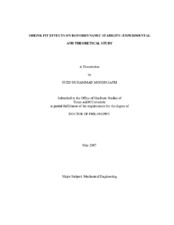| dc.contributor.advisor | Vance, John M. | |
| dc.creator | Jafri, Syed Muhammad Mohsin | |
| dc.date.accessioned | 2007-09-17T19:35:12Z | |
| dc.date.available | 2007-09-17T19:35:12Z | |
| dc.date.created | 2003-05 | |
| dc.date.issued | 2007-09-17 | |
| dc.identifier.uri | https://hdl.handle.net/1969.1/5849 | |
| dc.description.abstract | This dissertation presents an experimental and theoretical study of subsynchronous
rotordynamic instability in rotors caused by interference and shrink fit
interfaces. The experimental studies show the presence of strong unstable subsynchronous
vibrations in two different rotor setups with interference and shrink fit
interfaces that were operated above their first critical speeds. The unstable vibrations
occur at the first natural frequency of the rotor-bearing system. The instability caused
complete wreckage of the test rig in one of the setups showing that these vibrations are
potentially dangerous to the safe operation of rotating machines. The two different rotor
setups that are studied are a single-disk rotor mounted on a uniform diameter shaft and a
two-disk rotor with an aluminum sleeve shrink fitted to it at the outer surface of the two
disks. In the single-disk rotor, an adjustable interference arrangement between the disk
and the shaft is obtained through a tapered sleeve arrangement, which acts as the
interference fit joint. The unstable sub-synchronous vibrations originate from slippage
in the shrink fit and the interference fit interfaces that develop friction forces, which act
as destabilizing cross-coupled moments when the rotor is operated above its first critical
speed. The unique contribution offered through this work is the experimental validation
of a physically correct model of internal friction which models the destabilizing mechanism as a system of cross-coupled internal moments at the shrink fit interface. The
dissertation describes stability simulations of various test rotor setups using the correct
internal moments model. A commercial finite-element based software called XLTRCTM
is used to perform rotordynamic simulations for stability studies. The method of stability
study is the computation of eigenvalues of the rotor-bearing system. A negative real part
of the eigenvalue indicates instability. The simulations include the test rotors that were
experimentally observed as stable and unstable with shrink and interference fit interfaces
in their assemblies. The dissertation also describes the simulations of various imagined
rotor configurations with shrink fit interfaces, and seeks to explain how configurations
differ on rotordynamic stability depending upon several rotor-bearing parameters such as
geometry and elastic properties, as well as upon the amount of internal friction
parameters, which differ from configuration to configuration. | en |
| dc.format.extent | 6460772 bytes | en |
| dc.format.medium | electronic | en |
| dc.format.mimetype | application/pdf | |
| dc.language.iso | en_US | |
| dc.publisher | Texas A&M University | |
| dc.subject | Shrink Fit Effects on Rotordynamic Stability | en |
| dc.title | Shrink fit effects on rotordynamic stability: experimental and theoretical study | en |
| dc.type | Book | en |
| dc.type | Thesis | en |
| thesis.degree.department | Mechanical Engineering | en |
| thesis.degree.discipline | Mechanical Engineering | en |
| thesis.degree.grantor | Texas A&M University | en |
| thesis.degree.name | Doctor of Philosophy | en |
| thesis.degree.level | Doctoral | en |
| dc.contributor.committeeMember | Barroso, Luciana R. | |
| dc.contributor.committeeMember | Battle, Guy | |
| dc.contributor.committeeMember | Palazzolo, Alan B. | |
| dc.type.genre | Electronic Dissertation | en |
| dc.type.material | text | en |
| dc.format.digitalOrigin | born digital | en |


